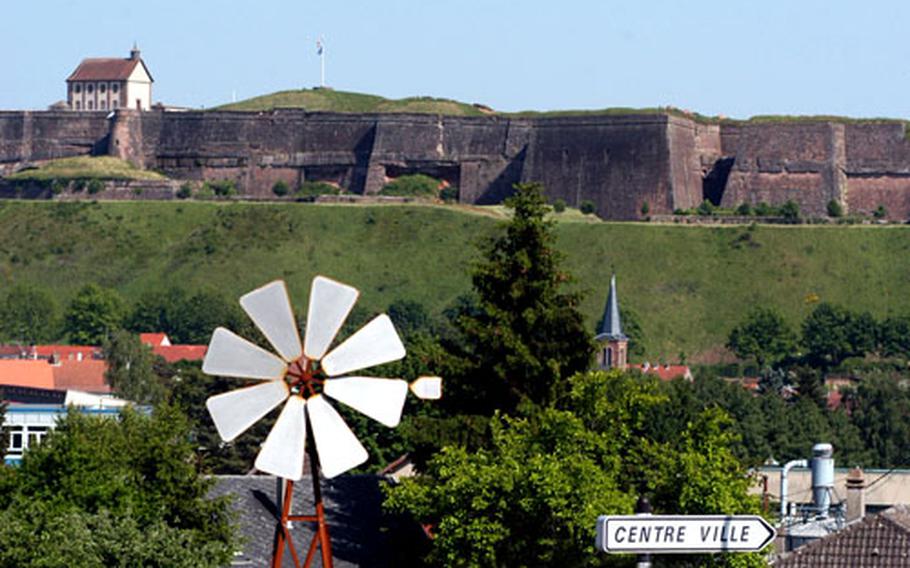
The Citadelle, one of the mightiest fortresses of France, dominates the town of Bitche in eastern Lorraine. (Peter Jaeger / S&S)
“Son of a Bitche.”
If he had known the famous American phrase, Col. Kohlermann might have used it for sure.
Kohlermann, whose first name is unknown and apparently lost to history, was commander of Bavarian troops surrounding the French town of Bitche during the Franco-Prussian war of 1870-71. He would have used the famous phrase to curse Louis Casimir Teyssier, stubborn commandant of La Citadelle, the mighty fortress overlooking Bitche in northeastern Lorraine.
Teyssier didn’t give up, he didn’t surrender his hard-hit fortress on top of a huge rock to the German troops. Under siege between August 1870 and March 1871, Bitche and its stronghold withstood bombardments and attacks by 20,000 Bavarian troops for eight months.
While the walls and buildings atop the rock were transformed into rubble by Bavarian artillery, life went on in the tunnels and casemates inside the rock. Equipped with strongholds and shelters, kitchen and stables, hospital and mess halls, served with water from a well 240 feet deep into the rock, Teyssier and his garrison withstood all attacks. They even held out for three weeks in March 1871, after Germany had defeated France and an armistice was signed.
“I need to get the word from Paris to surrender,” Teyssier declared.
On March 26, 1871, Teyssier handed over the keys of the fortress to Kohlermann and earned an honorable retreat with the survivors of his garrison.
Today in Bitche, one can soak up the atmosphere of a fortress under siege. The Citadelle of Bitche is a well-organized museum open to the public. With light and sound, music and slide shows, the old days of the Franco-Prussian war are brought to life. Along with the sounds of marching boots and the fanfare of attack, you almost smell the black powder and hear the screams of the wounded.
Earphones (English, French and German languages available) guide you through the fortress and through the centuries. Not only can visitors sample the famous siege of 1870-71, but also the history of the Citadelle, from its creation under French architect Sébastien Le Prestre de Vauban in the 17th century until the end of World War II.
A plaque on top of the fortress honors the fallen and injured American soldiers of the 100th Division of the Seventh Army that liberated Bitche on March 15, 1945.
Another museum on top of the fortress offers interesting relics of the wars and a fantastic model of the Citadelle dominating the town of Bitche.
On the QT ...
DIRECTIONS: Bitche is in the northeastern part of the Lorraine region of France, close to the German border, 15 miles south of Zwei- brücken.
From Kaiserslautern/Ramstein take Autobahn 6 to autobahn kreuz Neunkirchen onto Autobahn 8, direction Zwei- brücken. Leave the autobahn at Exit 33 toward Hornbach and follow Highway B-424 to the French border. B-424 becomes D35A in France. Follow signs to Bitche, just 13 miles away.
From Heidelberg, take Autobahn 5, direction Basel; switch at kreuz Walldorf to Autobahn 6 direction Mannheim. At dreieck Hockenheim go onto Autobahn 61 direction Köln; switch to Autobahn 65 at kreuz Mutterstadt. Leave Autobahn 65 at Exit 15/ Landau Nord. Go onto Highway B-10 direction Annweiler/Pirmasens. At Pirmasens switch onto Autobahn 8. Leave the autobahn at Exit 33 onto Highway B-424, direction Hornbach and Bitche. If there are controls at the German-French border, you will need a passport.
TIMES: La Citadelle is open from March 15 to Nov. 15 every day from 10 a.m. to 5 p.m. (July and August until 6 p.m.) The visit takes 1 to 2 hours.
COST: Admission (including headphones) is 6 euros (7 euros from May 1 until Sept. 30) and 5 euros for children and students (6 euros from May-September).
FOOD: There is a snack bar with outdoor café on top of the fortress next to the museum. Bitche has a number of restaurants, cafés and two supermarkets to buy food and drinks for a picnic.
INFORMATION: For info about La Citadelle, call the tourist office (Mon. through Sat., 9 a.m.-noon and 1:30-5.30 p.m.) at Bitche, located at the parking lot of the fortress. Phone: (+33) (0) 387061616; fax: (+33) (0) 387061617; e-mail: Office.tourisme.bitche@wanadoo.fr.
– Peter Jaeger